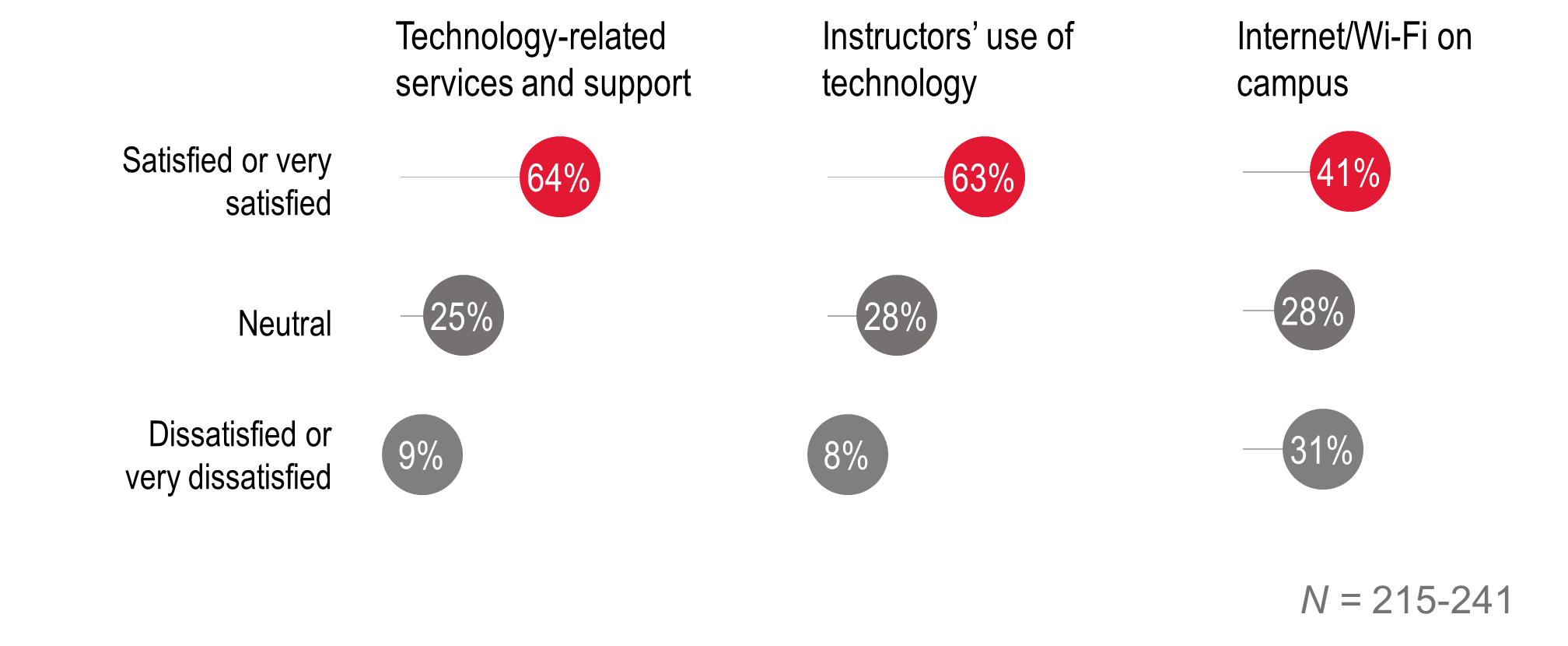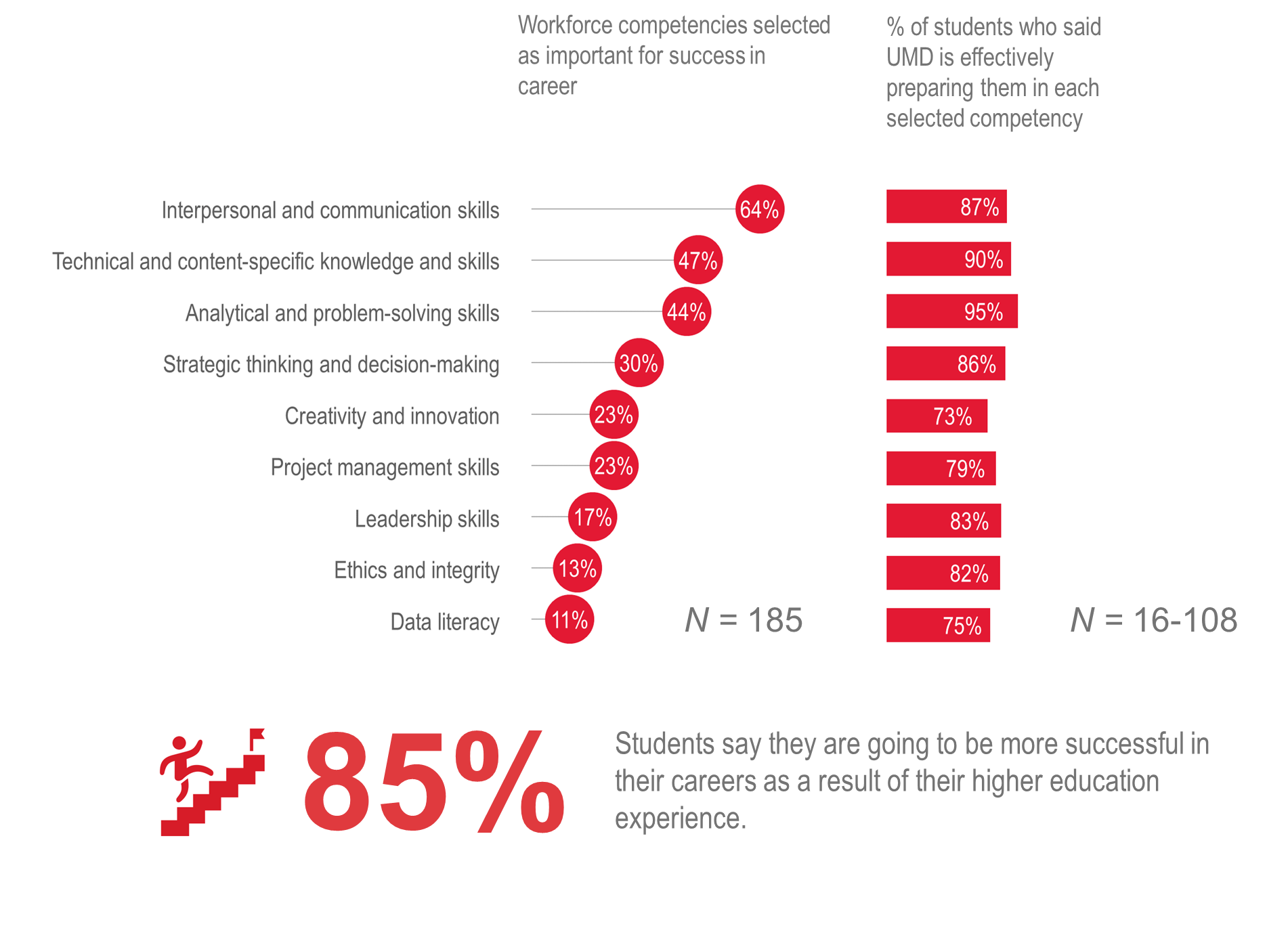The role of technology at UMD
The role of technology for students at UMD
Just as UMD is many things to many people, the role that technology plays within the current survey context is also multifaceted. To gauge whether our implementation of technology is meeting the community’s varied needs is a complicated effort, yet one key indicator is simple: broadly speaking, are students satisfied with the technology services, support, and uses at UMD? The answer for most students seems to be yes, with 64% saying they are satisfied or very satisfied with technology-related services and support, and the same percentage saying they are satisfied or very satisfied with instructors’ use of technology (Figure 2).
Most students are satisfied with technology support and services at UMD, as well as their instructors’ use of technology.

Figure 2. Student responses to the question: “Overall, how satisfied are you with:” (in order from left to right) “the technology-related services and supports you receive from your institution?”; “your instructors’ use of technology to engage you in course work?”; “the quality of internet/Wi-Fi service on campus?”
Technology facilitates learning
At a high level, the data suggest that the technology offered and implemented by instructors at UMD may fulfill core roles of facilitating learning and instruction. Beyond students’ overall satisfaction with their instructors’ use of technology, 71% of students said that it is easy or very easy to access and use the course materials assigned by instructors, a perception that is likely supported in part by instructors’ use of ELMS-Canvas to make materials readily available online. In fact, 86% of students who are satisfied with their instructors’ use of technology said it is easy to access and use course materials, compared to only 48% of students who did not say they were satisfied with instructors’ technology use (Figure 3).
Students who say they are satisfied with their instructors’ use of technology also say it is easy to access course materials.

Figure 3. A cross of student responses to the question, “Overall, how satisfied are you with your instructors’ use of technology to engage you in course work?”, and their responses to the question, “Overall, how easy or difficult is it for you to access course materials assigned by your instructor?”
When students were asked, in a write-in response question, about a time that an instructor used technology in a way that made their learning experience better, many referred to instructors providing course materials via ELMS-Canvas (15 comments, 13% of responses) or recorded lectures (19 comments, 17% of responses). For example, one student said they appreciate instructors “recording and posting lectures, making everything available on ELMS.” More students, however, pointed to ways in which instructors had used technology to promote student engagement (25 comments, 22% of responses), such as by polling students to enhance their understanding of material.
Technology connects Terps
More students are satisfied or very satisfied with Wi-Fi and internet on-campus (41%) compared to dissatisfied or very dissatisfied (31%) (Figure 2), and 59% said that it is easy or very easy to access a reliable connection on campus. This remains an area of necessary growth at UMD as demands on our network infrastructure continue to increase. In the Fall 2024 semester alone, there were over 270,000 unique users and over 350,000 unique devices connected to the network. The Campus Network Refresh Initiative is actively addressing concerns around reliability, speed, and coverage, for example, through upgraded infrastructure in 75 residence buildings as of Fall 2024. As the physical network refresh concludes this year, these current student perceptions will provide valuable baseline data to determine how UMD’s investment in new and expanded network infrastructure affects their online experience. The return on this investment, in fact, may already be showing: In one write-in comment, a student noted, “Wi-Fi is the biggest struggle, but it was definitely improved by the routers in every dorm room.”
Technology helps alleviate financial constraints
One very important role that technology can support is in alleviating students’ financial burden, particularly in light of the rising costs of higher education and, more recently, the troubled rollout of the Free Application for Federal Student Aid (FAFSA). While tuition is the primary expense for students at UMD, the Office of Student Financial Aid estimates that the yearly cost of books and supplies exceeds $1,000.
According to both students and instructors, this is one area in which instructors have leveraged technology solutions to reduce costs. When asked what instructors have done to help manage students’ financial constraints, over half of both groups pointed to practices that are made possible, or easier, by technology: namely, making assessments digital so that students don’t have to print materials (cited by 54% of students, 61% of instructors), and opting for cheaper or free textbooks or reading materials (58% of students, 65% of instructors) (Figure 4). Although this second point does not directly refer to technology, it is again likely that materials available via ELMS-Canvas and other online resources represent at least some of those that students and instructors are using in lieu of physical textbooks. For example, one student, when responding to the question about how an instructor had used technology to improve their learning experience, said that an instructor “enabled us to use the textbook for free through ELMS.”
Fewer students (16%) and instructors (30%) indicated that instructors had adopted more affordable instructional technologies for students to use. Given that UMD offers enterprise-wide solutions for common instructional technology needs (e.g., ELMS-Canvas for learning management, Panopto for recorded lectures, etc.) at no additional cost to students, it is likely that many instructors have not needed to consider more affordable technologies.
Most instructors use digital assessments and cheaper or free reading materials as a way of addressing financial constraints.

Figure 4. Student and instructor responses to the question: “Which of the following, if any, have instructors (/you) done to help manage student financial constraints in your courses in the current academic year? (Select all that apply.)” Other response options, not visualized, included “Don’t know”, “Other”, and “None of the above”.
Figure 5, below, shows the workforce competencies that students consider the most important (each student could select up to 3), along with the percentage of students who said that UMD is effectively preparing them in each selected competency. Notably, the only competency that a majority of respondents selected as important was interpersonal and communication skills (64% selected), rather than technical and content-specific knowledge and skills (47%), much less training in AI-powered tools (2%) or non-AI emerging technologies (1%). This finding speaks to UMD’s role regarding workforce and technology training writ large. UMD is not a technical college, and its primary commitments for undergraduate education involve fostering broader skills in critical thinking and collaboration. The data here suggest that UMD’s undergraduates share the goals of developing broadly applicable skills.
UMD is largely meeting those needs. Ninety percent or more of instructors reported that they incorporate into their courses the same workforce competencies that students identified as most important (interpersonal and communication skills: 97% of instructors incorporate; technical and content-specific knowledge and skills: 90%; analytical and problem-solving skills: 100%; strategic thinking and decision-making: 90%). For students’ parts, a majority (and up to 95%) said that UMD is effectively preparing them in these areas (Figure 5). This likely contributes to their perception, shared by 85% of students, that they are going to be more successful in their careers as a result of their higher education experience.
Most students feel that UMD is preparing them in workforce competencies that they consider important to their careers.

Figure 5. Left: Student responses to the questions: “Which of the following workforce competency areas, if any, do you expect are going to be most important for your success in your desired careers? (Choose up to three.)” Competencies selected by at least 10% of students are visualized. Right: Student responses to the question: “Do you believe your higher education experience is effectively preparing you in each of the areas you selected as most important?” Bottom: Student responses to the question: “Please rate your level of agreement with each of the following statements: I am going to be more successful in my desired career as a result of my higher education experience.” (% selected Agree or Completely Agree).
On the technical side, however, there is some room for improvement. Only 72% of students agreed that they are getting equipped with all the skills they need for their desired career, and only 63% said that their higher education experience is teaching them how to use the technologies they’ll need. It is not clear the extent to which it is feasible or even desirable for UMD to provide undergraduate training in every skill or technology a student might need, as some of this necessarily falls into professional training, graduate work, and other post-baccalaureate programs, according to their specific career paths. Nonetheless, as we will see in the next section on generative AI, there are likely broader areas of technical expertise in which students could feel better prepared.
